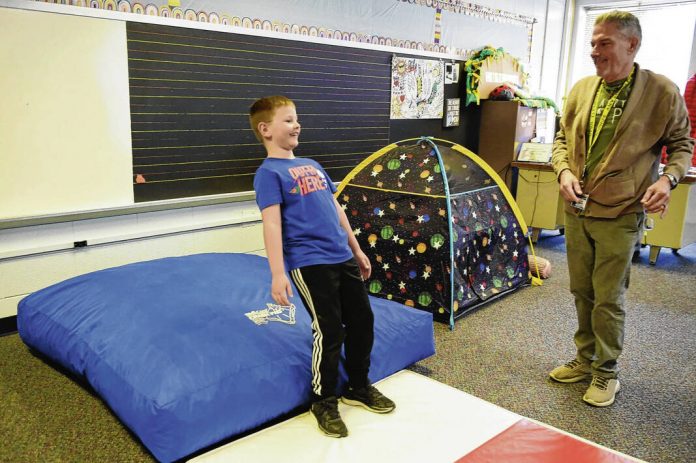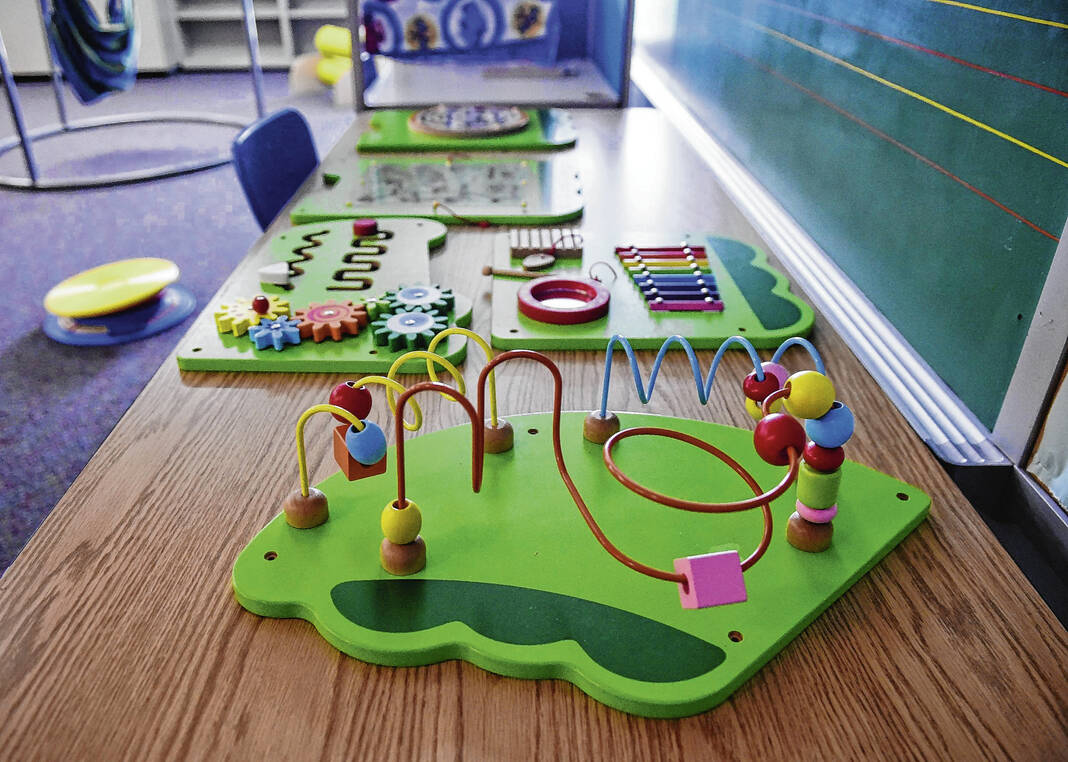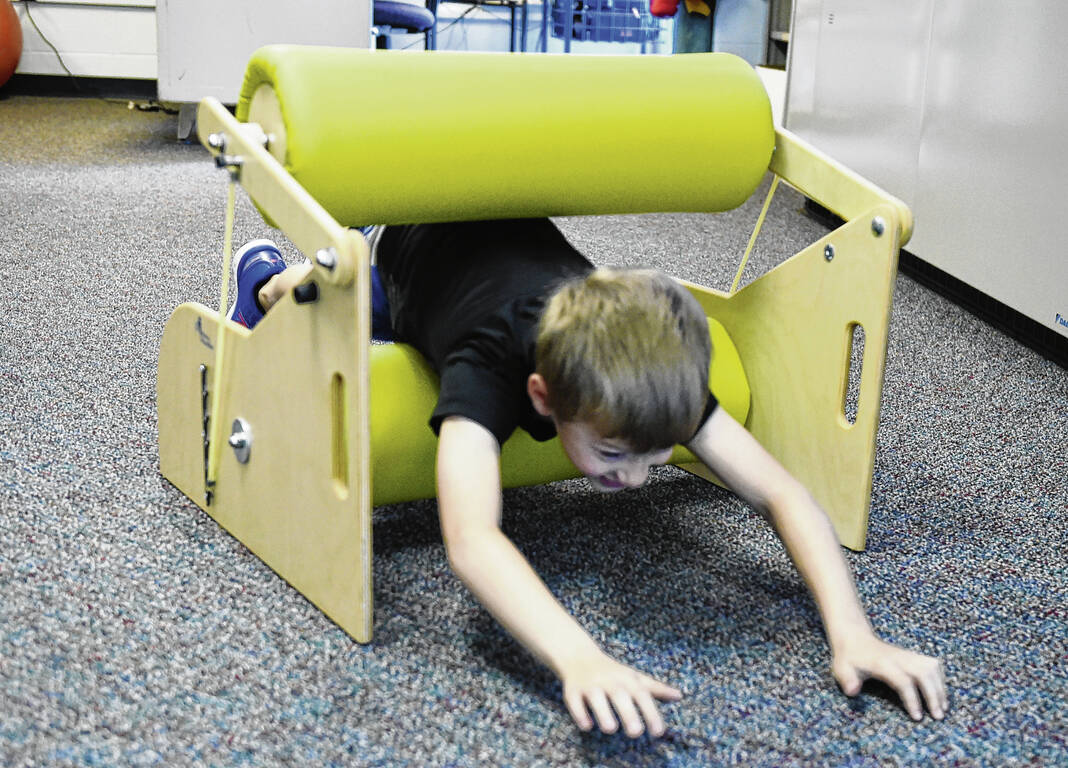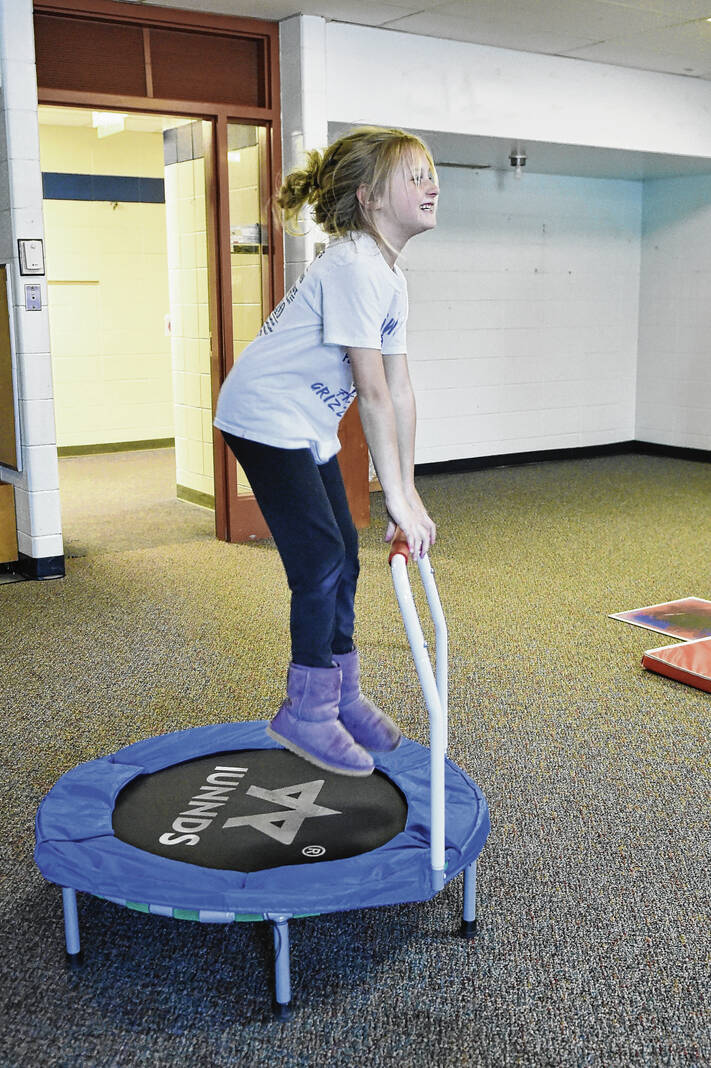
Parker Hoesel, a second grader at Webb Elementary School, demonstrates a trust fall inside the school’s sensory room while Doug Adams, the school’s behavioral interventionist, watches. Webb was able to add the room in partnership with Grace United Methodist Church, which gives educators resources to help children struggling with sensory needs.
RYAN TRARES | DAILY JOURNAL
When the flood of emotions became too much to handle, the room was a respite.
Doug Adams knows that when students walk through the door of the sensory room inside Webb Elementary School, they’re struggling. Something has overstimulated them, and the children don’t know what to do with how they’re feeling.
In the past, students may have been punished in ways that did not help with their emotions. But with tools inside the sensory room, Adams — the school’s behavioral interventionist — has a more effective away of calming them down.
“We call it flipping the switch,” he said. “The old goal was to make them so miserable they stopped acting out. Our goal is to get them to want to get to back into class, and these are the items that actually do it.”
Webb’s sensory room has become a positive tool in helping all students at the elementary school. Created with support from Grace United Methodist Church, the space features a variety of equipment — from trampolines to a swing to tactile mats — which research has shown to be effective in helping counter sensory overload.
To able to provide such a place for its students has been a welcome change, said Angie Clendening, counselor at Webb.
“Just like schools everywhere, we try to meet their physical needs — if they’re hungry, if they need food, if they need a hug. Sometimes, they need a sensory break,” she said. “As adults, we can control our day. If we need to get up and take a walk or get a drink of water, we can do that. Kids don’t have that luxury, so sometimes they need a quick break to reset and be available.”
Sensory rooms have become a valuable asset for educators to enhance and promote the health and well-being for not only special education students, but all students, according to the National Council for Special Education.
The designated spaces contain special equipment intended to reduce sensory overload for students who may find the school day overwhelming and enable them to achieve a calmer state for learning.
Sensory spaces can also provide increased sensory input for students who require more stimulation to enable them to regulate their sensory and emotional needs, according to research. Those spaces can incorporate mindfulness activities to support interceptive awareness to facilitate self-regulation and support social and emotional learning.
Research by Grand Valley State University in Michigan found, after analyzing the use of sensory rooms in four schools, that students were more engaged after participating in the sensory room break.
Those results have been reflected at Webb.
“The kids love it. Our therapy dog Millie is in here quite a big with Doug, and sometimes kids will earn time to spend with Millie so we’ll have picnic lunches and the kids can use the equipment,” Clendening said. “Every kid in the school thinks this is a great place. It gets used a lot. We’ve learned a lot about kids’ sensory needs.”
Webb had been wanting a room with this type of equipment for many years, Clendening said. But room didn’t exist in the school’s budget to acquire it.
A solution to the problem came in 2019, when leaders from Grace United Methodist Church approached school officials about doing something to help them. The school and church are neighbors, and have worked together on projects in the past.
But this time around, the church congregation wanted to offer help on a long-lasting project.
When they learned the school was hoping to implement a sensory room both sides got excited.
“We’ve done some research on children and special needs that some children have, and we learned about this concept of a sensory room,” said Andy Kinsey, pastor at Grace United Methodist Church. “We have a special relationship with Webb, and have tried to help in the past in all kinds of ways. We felt this was a good investment for those children whose emotional needs were acute.”
The church applied for a grant from Metro Ministries, an organization that helps United Methodist churches meet various needs in their community, and received it. The funds covered the cost of equipment and other aspects of the sensory room.
“We were thrilled. Doug and I went through catalogs and found things that would work and be helpful,” Clendening said. “It took off from there.”
Room design started in 2020, though was paused due to the Covid-19 pandemic. The room became available to students in early 2021.
When a classroom situation arose that was disrupting learning of other students, Adams goes to get the struggling student and bring them to the sensory room. The first step is to have the child sit down in a desk.
“I try to be as non-verbal as possible, so I’ll point, and they sit down and chill out for a little while,” he said.
After the student has calmed down, Adams has them go through a rotation of stations designed to calm them and release their emotions. They spend between three and five minutes at each station, depending on how bad the outburst was, before moving to a new one. At most, they are in the room for 15 minutes, Adams said.
They spend time bouncing on a trampoline, one of the most effective brain-engaging activities they can do, Adams said.
“The medical community says that there’s nothing better for your brain than jumping on a trampoline. It lights your whole brain up,” he said.
The children can sit in a hammock swing, where they can spin around and refocus their energy. You can see the weight fall off of them, Adams said.
Some of them take time on a sit-and-spin toy. They can crawl through what Adams calls a “squeeze-me-tight” — what looks like a giant foam wringer the kids go headfirst through. Others sit in beanbag chairs watching a sensory display of colors, with calming music in the background.
All of the tools have been proven through research to appeal to students with sensory issues — in addition to other students.
“There are visual things and things for kids to look at and focus on, because we have such a wide range of students,” Clendening said. “It’s really for every student. We’ve had kids who aren’t really acting out, or it’s not an emergency situation, but they need particular forms of stimulation. Within a few minutes of being here, they’re back to being at work.”
Adams stresses that the sensory room doesn’t work for everybody; each child is different, and different factors play into its success.
But the positive impact has been undeniable.
“It’s flipped my concept of doing this job,” Adams said. “Before, it was kind of like, growl at kids and get them to behave. Now, we actually have things we can use. We went from having none of it to having the top things for the best sensory room.”













